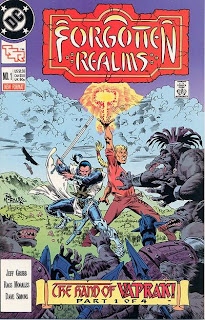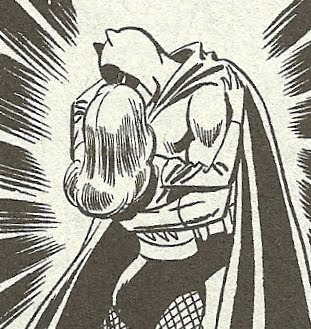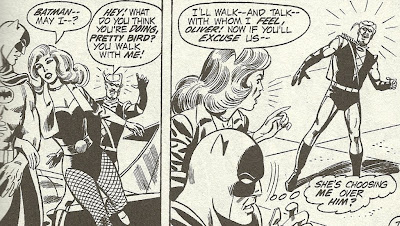 Yesterday I ran a panel from Fred Van Lente and Ryan Dunlavey’s Comic Book Comics #5, a panel which I thought offered a nice, elegant response to the “The Families of Creators Comics Published Once Ripped-off Are Greedy Evil For Pursuing Their Legal Rights And Thus Maybe Endangering My Steady Stream of Superman and X-Men Stories!” line of argumentation that seems a staple of comment threads.
Yesterday I ran a panel from Fred Van Lente and Ryan Dunlavey’s Comic Book Comics #5, a panel which I thought offered a nice, elegant response to the “The Families of Creators Comics Published Once Ripped-off Are Greedy Evil For Pursuing Their Legal Rights And Thus Maybe Endangering My Steady Stream of Superman and X-Men Stories!” line of argumentation that seems a staple of comment threads. One of the many, many pleasures of the pair's Comic Book Comics series has been their portrayal of comics creators, often by using their characters as stand-ins. For example, in a panel discussing Neil Gaiman and Todd McFarlane’s legal battles over Marvelman/Miracleman, Dunlavey drew Morpheus and Spawn each tugging on a different arm of the contested Marvelman character.
Sometimes they hybridize character and creator. For example, their Walt Disney usually appears as Mickey Mouse with Disney’s human face in place of Mickey’s saucer eyes and mouse snout, and their Jerry Robinson has the hairstyle and wardrobe of The Joker in some panels.
One creator they always draw more-or-less straight is Alan Moore, whose Old Testament hair and beard and intense eyes make him one of the comics creators who is every bit as visually interesting as many of the characters he has written.
In the story “1986 AD” from Comic Book Comics #5, Moore appears repeatedly, as a child selling LSD to a police bobby, as a janitor, riding upon a rocket ship with Dave Gibbons, working as a janitor and so on.
Here are two of my favorite pictures. Moore and Gibbons pursuing Moby Dick, who is cosplaying as Rorschach…
 …and this image of Moore as a child…
…and this image of Moore as a child…
**********************
In the comments to Monday’s post about IDW’s recent collection of the old DC/TSR Forgotten Realms, commenter “A Hero” pointed out this post regarding the collection on writer Jeff Grubb’s blog.
In it, Grubb talks a bit about how he found out about the collection, how it apparently came together, and his dealings with all of the parties to see if he would be getting paid anything since they were reprinting the stories he wrote.
Here’s Grubb’s recommendation for how those interested should proceed, keeping in mind that it doesn’t look like he or Rags Morales or the other creators are making any more money off the collection:
So now what? Call my horde of fans to block this horrible trammeling of a contract? Protest in the streets? Fight for creative rights? Camp out in the state capital? Call for a boycott?
Nope. Instead I’m going to recommend you BUY a copy.Is it okay if I just do it here?
…
THEN, of course, I want you to write to IDW (and Hasbro) and tell them how WONDERFUL the story and art is. And how they should (sparing no expense on their part) HIRE the talented team of Grubb and Morales, who obviously understand how the D&D universe works and are fine examples of writer and artist and a shining addition to ANY comic book line.
Okay, here goes.
Dear IDW,
I greatly enjoyed your recent collection of the old TSR/DC Forgotten Realms comics, which I think are the best Forgotten Realms comics ever (I didn’t much care for that business with the Drow elf who has all the z’s in his name that I think Devil’ Due published a few years back).
In fact, I liked them so much, that I bought some of ‘em twice, the second time from you.
The story was wonderful. The art was also wonderful. You should totally hire the talented team of Jeff Grubb and Rags Morales, who would be a shining addition to any comic book line. Especially a fantasy comic book series, and especially a fantasy comic book series based on Dungeons & Dragons business.
I probably wouldn’t buy the books that resulted in their serially published format—Sorry, I can’t afford $4 comics on a freelance writer-about-comics’ “salary”—but I swear I’ll buy the trade collection. Probably form Amazon.com. And then I’ll write about it on the Internet, like I’ve written about this collection like eight times already.
Sincerely,
J. Caleb Mozzocco
P.S. You know what else you should do with that D&D license? A Bizarro Comics/Strange Tales-style anthology series.
P.P.S. If you want to read a pitch for a G.I. Joe miniseries in which Polly, Timber, Junkyard and Freedom team-up to save the Joes from a nefarious Cobra plot, just let me know!
Dear Hasbro,
Thank you for inventing Hulk Hands. Those things are the best.
Your pal,
J. Caleb Mozzocco
P.S. The story and art in those old DC/TSR Forgotten Realms comics IDW just collected are WONDERFUL—all caps, in bold, that’s how wonderful they are—and you should (sparing now expense) HIRE the talented team of Grubb and Morales, who obviously understand how the D&D universe works and are fine examples of writer and artist and a shining addition to ANY comic book line.
Hope that helps, Mr. Grubb!
********************
Grubb also talked about some behind-the-scenes business with those old DC/TSR comics and how they originally came about in this post on his blog. This is basically the exact sort of thing I would have liked to see in an introduction to the Forgotten Realms trade.
I didn’t pay much attention to credits back then, but it turns out Grubb wrote one of my favorite arcs on the AD&D book, the “Catspaw Quartet” four-parter in which Onyx and Timoth adventure in the sewers of Waterdeep, before launching the Forgotten Realms monthly.
Here’s how he describes the approach to the books:
Big thing about the AD&D and FR comics – these were fantasy books about characters that knew they lived in a fantastic universe. They were aware and capable of handling their situation. This wasn’t part of a “points of light” where sinister stuff lurked over the next hill. It wasn't a dark fantasy world. Those are cool, but the Realms ran off the assumption that its heroes were smart enough to know about their world.I think that likely contributed to the generally light-hearted feel of the books. While there were some very serious issues in AD&D—slavery, betrayal and war came up a couple of times—the bulk of that series was really fun fantasy adventure.
Grubb also discusses the end of the TSR/DC alliance and the cancellation of the books. I always assumed it was because they sold poorly, which was the reason most comics get canceled. Turns out there were some poor business choices made. Now I wonder how much longer the books might have lasted on the merit of their sales alone. The books were all ended right about the time the comics market was entering into it’s crazy 1990’s speculation boom phase.
********************
I seem to have been one of the few comics readers who didn’t mind the TV Wonder Woman costume as it was first revealed all that much. Part of the reason, I think, is that the standards for live-action television superhero costumes are soooooo much lower than they are for live action movie superhero costumes.
For example, remember Smallville’s JSA costumes? Or have you seen TV Guide’s reveal of the new Blue Beetle’s costume as it will appear on Power Range—Er, Smallville?
Look at the Wonder Woman costume. Then look at the Blue Beetle costume. Then look at the Wonder Woman costume again. See, that Wonder Woman costume doesn’t look so bad anymore, does it?
Speaking of which, you can see newer, better images of the costume here. It looks tweaked here and there, like giving her back her red boots (to my dismay), and pants that look more like pants than something cobbled together from blue raspberry Fruit Roll-Ups.
I suppose I should note that the Booster Gold costume looks pretty good in that single image released, as a real-world version of his costume. It even has the little Nascar-like patches, as seen on J.G. Jones’ covers for 52.
********************
 It looks like Kevin Maguire is referencing his own references of his own cover from 1987's Justice League #1 for the cover of Justice League: Generation Lost #24 (as revealed in this Source blog post on upcoming variant covers).
It looks like Kevin Maguire is referencing his own references of his own cover from 1987's Justice League #1 for the cover of Justice League: Generation Lost #24 (as revealed in this Source blog post on upcoming variant covers). For some reason, DC has had Maguire, the artist best associated with the characters starring in the series, providing variant covers to JL:GL, while other artists provide the normal covers. Some of those artists and their covers have been pretty rotten, particularly right at the outset, although since first Cliff Chiang and then Dustin Nguyen took on the gig, they’ve all been pretty swell.
Still, if I had the choice, I’d almost always choose the Maguire covers. I haven’t had a choice though. I’ve been reading the series and enjoying it, largely due to the bi-weekly schedule. In retrospect though, I wonder if I maybe shouldn’t have trade-waited it, if only to be able to (presumably) get all the Maguire covers that way.
It is my strong belief that DC should hire Maguire to draw each new iteration of the Justice League line-up in that looking up at the reader as a group pose. I don’t think I’ve seen it since he did the Morrison JLA on the cover of an issue of Fanboy, though.
 I sure would have liked to see him do the Meltzer/Benes League, or the current Congorilla and friends League…
I sure would have liked to see him do the Meltzer/Benes League, or the current Congorilla and friends League…*******************
Speaking of covers, as I’ve mentioned before, I always enjoy reading Kelly Thompson’s “Cover Solicits in Three Sentences Or Less…” features, which she recently tweaked so that she writes them while drunk now (Here’s her latest DC column, and here’s her latest Marvel column.)
Part of the reason I like them is because they’re funny and offer a perspective I don’t normally think too much about (like whether the artist seemed to be looking at a model with fake breasts or real ones when drawing a particular cover, a topic which got much discussion in this month’s round; Hey, Kelly, if you’re reading, can we tell if the new TV Wonder Woman has fake breasts or not looking at the action shots of her running in her costume? Because if they hired an actress with fake breasts to play Wonder Woman that strikes me as kinda sad…).
Also, Thompson’s rules keep her observations very tightly focused on the cover images, whereas every time I write about the DC and Marvel solicitations I always end up getting distracted and going off on long tangents about continuity and publishing strategies.
Also also, I always notice things when I re-look at the covers in her columns that I missed the first few times I saw the cover.
For example, you know that book Fear Itself: The Fearsome Foursome, which features both Man-Thing and Howard the Duck on the cover?
 There are five characters on the cover!
There are five characters on the cover! (Also, Howard the Duck is still wearing pants? What’s the point of Marvel selling to Disney if they can’t take Howard’s Disney-mandated pants off yet? Can they at least compromise and give him shorts?)
June’s cover for Herc features the title hero battling a tentacle monster. He seems to fare differently than the ladies from Heroes For Hire did when they fought tentacle monsters:
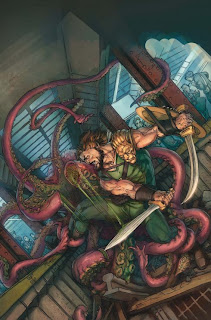
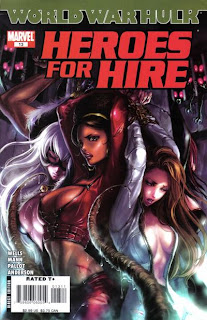
***********************
 Alan Kistler’s latest Agent of S.T.Y.L.E. column at Blog@Newsarama focused on DC’s Batwoman character. While discussing the costumes of the two Kate Kanes, Kistler mentioned the Batwoman costume from the 2003 direct-to-DVD Batman: The Animated Series movie, Mystery of The Batwoman. I rather liked that costume, in part because of how different it was from most other feminine versions of a Batman costume (It even had pink in it! Pink!)
Alan Kistler’s latest Agent of S.T.Y.L.E. column at Blog@Newsarama focused on DC’s Batwoman character. While discussing the costumes of the two Kate Kanes, Kistler mentioned the Batwoman costume from the 2003 direct-to-DVD Batman: The Animated Series movie, Mystery of The Batwoman. I rather liked that costume, in part because of how different it was from most other feminine versions of a Batman costume (It even had pink in it! Pink!)The one it most closely resembled was, of course, the Cassandra Cain Batgirl costume. When thinking about fixes for that costume, which can look fantastic or dreadful, depending on who was drawing it, my mind would often return to this animated Batwoman’s look. I think if Cassandra’ Cain’s costume were to bend in the direction of this costume, it would retain some of it’s most appealing elements (As I’ve said before, I think that Batgirl costume, particularly as drawn by Damion Scott, featured the best aspects of both Batman and Spider-Man), while smoothing out some of the more difficult elements, like the stitching on the face and the black eye lenses in a black mask.
I don’t really understand how animated Batwoman’s mouth works—I watched it once a long time ago, and now I don’t recall where the costume came from…I think it was just fabric, with a whole cut perfectly in the shape of the mouth around the mouth, but I don’t know, maybe it was some kinda sci-fi smart cloth, nanite thingee.
Anyway, turn that Batwoman costume black, replace the pink with yellow and/or black, and give Cass back her big, goofy utility belt (Is it weird she has the biggest utility belt pouches of all the various Bat-people, but used the least amount of weapons and gadgets? Maybe they’re full of sandwiches?), and I think that would be a fine Cassandra Cain Batgirl costume that it would be very difficult for artists to not draw well.
Because I’m not computer-smart enough to just recolor existing images—and because I need something to do with my hands and the part of my brain the TV show fails to engage while I’m watching Dancing With the Stars—I drew Batgirl over and over in my sketchbook the other day.
This is a lame-o sketch of her original costume, although I think her bat-symbol is usually just an outline of yellow, not solid yellow:
 If you took out the stitches and gave her white eye lenses for something approaching animated Batwoman, I think you’d get something like this:
If you took out the stitches and gave her white eye lenses for something approaching animated Batwoman, I think you’d get something like this: Then I wondered what she’d look like if you kept Batwoman’s pink in her costume:
Then I wondered what she’d look like if you kept Batwoman’s pink in her costume: (The pose, by the way, is swiped from Scott’s cover to Batgirl #25). Cassandra Cain isn’t exactly a pink-wearing kind of girl, but then, maybe that in itself would be a reason for her to try out some pink. Like, a self-conscious attempt to try and be more stereotypically girly…?
(The pose, by the way, is swiped from Scott’s cover to Batgirl #25). Cassandra Cain isn’t exactly a pink-wearing kind of girl, but then, maybe that in itself would be a reason for her to try out some pink. Like, a self-conscious attempt to try and be more stereotypically girly…? Before I colored those in, I got to wondering how the costume might look if instead of yellow or pink, she went with white. I suppose that would make it sort of Punisher-y, but white is such an anti-Batman color, as much as pink is, that I thought it might look interesting:


 (The last pose is another swipe from Scott, from the cover of Batgirl #20, featuring Batgirl and Spoiler on it. Scott is about the only artist who drew Spoiler in a way that her design actually seemed sort of cool to me).
(The last pose is another swipe from Scott, from the cover of Batgirl #20, featuring Batgirl and Spoiler on it. Scott is about the only artist who drew Spoiler in a way that her design actually seemed sort of cool to me). Of course, in real-life the gloves would be caked brown around the hands, from dried blood bad guys would spit when getting punched and from the grime one gets from climbing around on Gotham City fire escapes and rooftops all night. Surely Alfred would forbid white in any Bat-costume he had to launder.
Cassandra Cain hasn’t shown up much in the comics at all lately. I heard there was an appearance in Red Robin in which she explained that she didn’t want to be Batgirl or was on sabbatical or something, but I didn’t read it—I gave up following characters a long time ago, and that’s not a book I was reading.
The last time I saw her was in Tiny Titans #33, the “all-Robin issue,” which introduced Tiny Cassandra:
 I suppose Tiny Titans is an unlikely place to look for DC superhero costume redesign ideas, but I kind of liked Baltazar’s version of that Batgirl costume. Not only did he simplify the stitching quite a bit to give the costume more of homemade feel (and I kinda dig the stitches-as-eyelashes bit around the eyes), but his Cassandra Cain has a skirt on.
I suppose Tiny Titans is an unlikely place to look for DC superhero costume redesign ideas, but I kind of liked Baltazar’s version of that Batgirl costume. Not only did he simplify the stitching quite a bit to give the costume more of homemade feel (and I kinda dig the stitches-as-eyelashes bit around the eyes), but his Cassandra Cain has a skirt on. Now obviously Cassandra isn’t much of a skirt-wearer, so this Batgirl in a costume that includes a skirt no doubt seems out of character.
Now obviously Cassandra isn’t much of a skirt-wearer, so this Batgirl in a costume that includes a skirt no doubt seems out of character.But then I started thinking about it, and how much harder it would be to fight in a skirt than it would be in a pair of tights.
I don’t know if many of you have read the later Dragonball comics or watched Dragonball Z, but there are a couple of parts where it’s revealed that grown-up Goku and Piccolo wear heavily-weighted costumes as part of their training, so you know they’re either getting really serious or are in over their heads in a fight when they remove their weights, so they are suddenly much faster and stronger.
So I could sort of see Cassandra Cain wearing a kick-restricting skirt as a form of self-imposed handicap, either to help her train or to artificially weaken her to make fighting more rewarding. After all, she has a body language-reading ability that borders on a superpower, and can fight as well or better than Batman and Lady Shiva (and she’s still a teenager), so day-to-day mugger and henchman-fighting is probably pretty boring for her.
If I had to assign a motivation for her current costume, I would think fighting-ability handicapping might be a good rationale. Why else wear a mask that reduces visibility, a big, long, dragging cape, and those big utility belt pockets? (Maybe they’re full of weights?).
So while it doesn’t really seem to be in character for Cassandra Cain’s Batgirl to ever rock a skirt, I think it could certainly be rationalized. Hell, high heels too!
Although under Baltazar’s pen, I assume he put her in a skirt just because it looks cute.

















